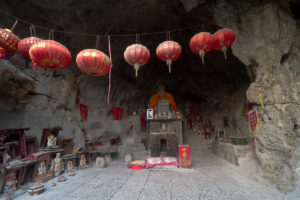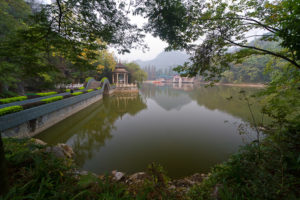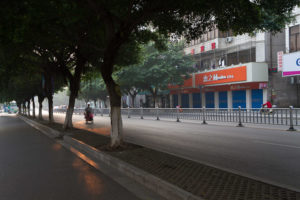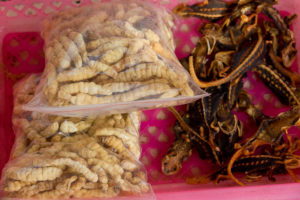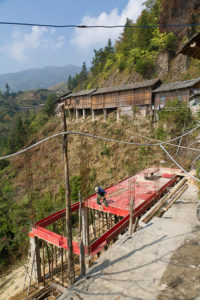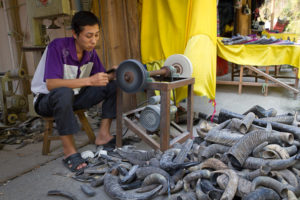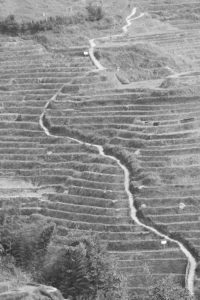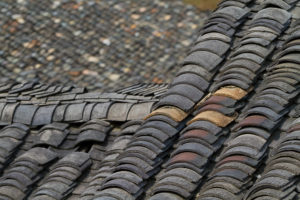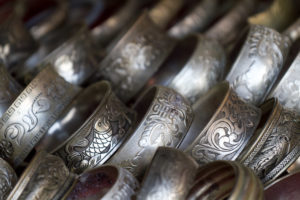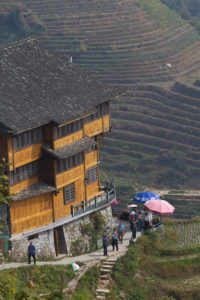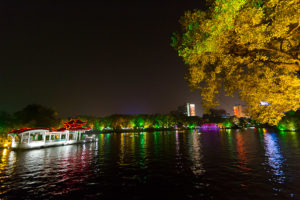After walking for 15 minutes or so, I arrived at the XiShan Park gate, which appeared to be ‘open’, though the gate appeared to be set up for payment to enter. Steep-sided limestone hills rose in every direction and I took the first pathway that led upwards, up past small pagodas on lookout points, with each having one or two older Chinese people practicing tai-chi. Some loosely slapped arms to and fro, one guy walked the stairs up and down, and another repeatedly slammed his back into a treetrunk, over and over. The path rose above a pond below, the other side of which was another steep hillside, though it appeared only a dirt trail ascended it. Every several minutes the silent, ethereal ambience would be broken by one of these individuals, screaming at the top of their lungs for an entire breath, sometimes being answered from somewhere in the mist across the pond.
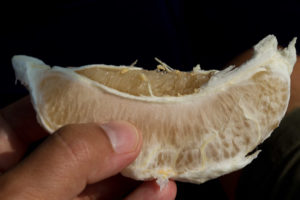 |
| The wondrous pomelo! |
As we drove toward Longsheng, we passed through an area where roadside stands had bushels and bushels of these big, round, greenish-yellow fruits we’d noticed in Vietnam. Fortunately, our tour guide Sunny bought two for the bus-full of us to try. They were a citrus fruit resembling a very large grapefruit called honey pomelo. The rind was nearly an inch thick, yet fairly easy to peel. It was nearly the size of a small child’s soccer ball, and once you peeled the white covering from each section the fruit inside was similar to both an orange and grapefruit, but separated quite nicely out of the skin. It was very ‘meaty’ and not overly juicy (thus not a mess to eat), but the flavor was absolutely delightful, sweet and slightly tart (but not acidic), reminding me of the aroma of some kind of flower nectar. Remarkably, the honey pomelo is indeed worthy of an entire paragraph of this blog, as it is without question my favorite fruit, citrus or otherwise. [/tangent]
The bus climbed windy roads toward Longji Mountain Village, a terraced-culture community in Longsheng County, two hours from Guilin. The road ended in a parking lot where a pathway led upwards toward the village amongst terraced rice and vegetable fields, most of which had been recently harvested. Zhuang and Yao peoples inhabit this region, the former of which is the largest ethnic minority in China, the latter of whose women never cut their hair after age 18. The Yao women are fierce and aggressive vendors unlike any in Asia we’d yet encountered, unwilling to take a ‘No’ answer for long minutes of following and repetition.
Walking upwards along the pathway lined with sidewalk vendors, it contoured along the hillside, in and out of bamboo groves at the lower elevations, intermittent narrow stairs along the way. For a mountain community in which walking was certainly the primary means of transport, they had a remarkable array of products to sell, from the locally-made water buffalo horn combs so common in Guilin, to fabrics, wall hangings, rock art, and foods of all sorts and scents. Wooden structures were built upon concrete pillars anchored into the hillsides, many of which were several stories high, perched on the hillside with incredible panoramic vistas, unfortunately the views of which were once again befouled by the ubiquitous air pollution of the region.
We had lunch in one of the multi-level buildings near the top, and after asking our Guide about the bamboo sticks I’d seen in sidewalk firepits, he ran out and procured a few from a vendor. It was BBQ’d sticky rice, lightly seasoned, stuffed into a 2” wide bamboo, the topside of which is then plugged with a corncob. The bamboo is literally broken open, and then the rice cut into sections and eaten. By the way, did I mention the ‘free glass of local beer with meal’ that seems to be the norm here? I’m a fan!
After lunch I took my typical early leave of the table to wait for the group to conclude eating while standing outside watching the world go by. Accustomed to watching the endless drone of scooters rip past any street restaurant in places from Morocco to Vietnam, this was an especially unique experience, watching how the world works in a community connected by stairways rather than streets. Hannah and Kevin joined me for the walk back down; we stopped where a toothless guy was mechanically pressing fresh sugar cane into cups of juice, and we tried a cupful (all $0.25 worth). Big surprise, it was just like sugar water. Warm sugar water. We somehow resisted the temptation to try the flattened roasted-whole birds or dried lizards we subsequently came across.
What people do with some of this stuff I can’t imagine, but I wasn’t able to resist one of the quirks that Heidi still refuses to understand about me: I bought some rocks. Yes, rocks. The limestone which gives rise to the incredible karst topography of the region is cut into slabs, portions selected to be cut and polished into small rock art. Some of the iron staining can almost look like ancient Asian watercolors of landscapes, and I was captivated by them, the larger of which were two feet across and surely would be prohibitively expensive to ship. Unfortunately.
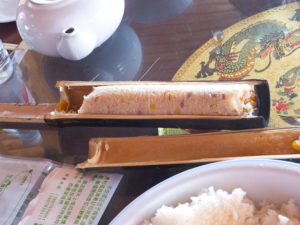 |
| Bamboo rice |
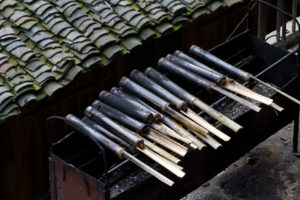 |
| Bamboo rice on the grill |
After returning to the hotel and having dinner, Alan and I once again checked out the Guilin Night Markets, and then walked a lap of the larger, eastern side of Rong Hu Lake park. Now, as much as I’d like to end this particular blog post in the interest of not droning on in endless rambling prose describing something you may never be able to experience, let me tell you that the community parks in China are quite simply stunning. Not 100 meters from the hotel, we encountered a lakeside pagoda where some people were playing mostly Chinese instruments, with one lady singing occasionally. There were perhaps two dozen people seated within the pagoda watching, with people stopping along the pathway to watch and listen. Amazing.
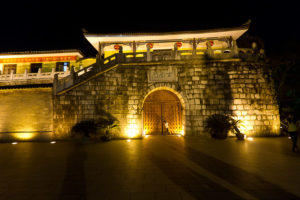 |
| The Gu Nan Men ancient South Wall, in the city of Guilin. |
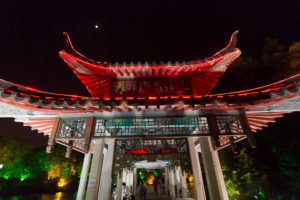 |
| The exterior of the ‘building in the lake’ |
As we continued along the lake, pathways occasionally split off in different directions, sometimes leading to little sitting areas along the lake, other times to rock sculpture gardens, bridges, or areas where the intermittent water fountain show (a la that Vegas hotel I thankfully cannot come up with the name of) could be seen. There was an ornate walkway meandering to and fro through the middle of the lake to a small island with a beautiful open-air building at one end. Alan and I were walking behind two fancily-dressed women who were walking the same direction toward the building, me occasionally stopping to look at the incredible limestone rocks that were carefully perched to look like natural stone monuments, surrounded by impressive vegetation and lighting. Once we got to the building, there were a few men present sitting on benches, but no women. The two ladies that had been in front of us were gone. Strange, I thought, as I was certain our path was heading to this pagoda-like building, beyond which was only water. All of a sudden an inconspicuous door opened in the corner of the building at the far end, and I realized that this building was simply a bathroom!
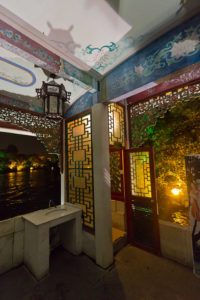 |
| The bathroom! |
Astonished by both the peacefulness and exquisite beauty of this one park in the city of Guilin (granted, now a major domestic tourist destination since the 1980s), we continued around the lake where we came upon the park’s namesake, the 800-year old Rong Hu Banyan Tree, the elevated trunks of which had been preserved from destruction using concrete pillars to prop them up. Not much further was Gu Nan Men, the remains of Guilin’s ancient South Gate (possibly dating back to the Qin era, 6thcentury AD). There were people of all sorts quietly enjoying the park everywhere, and I went to sleep late that night contemplating the ethereal and serene beauty of but a single park in the middle of a city of 620,00 people, somewhere in this country of nearly 2 billion.
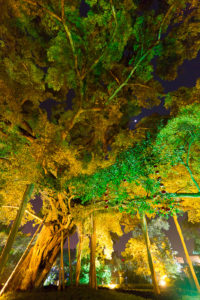 |
| The 800-year old Rong Shu Banyan Tree. |



